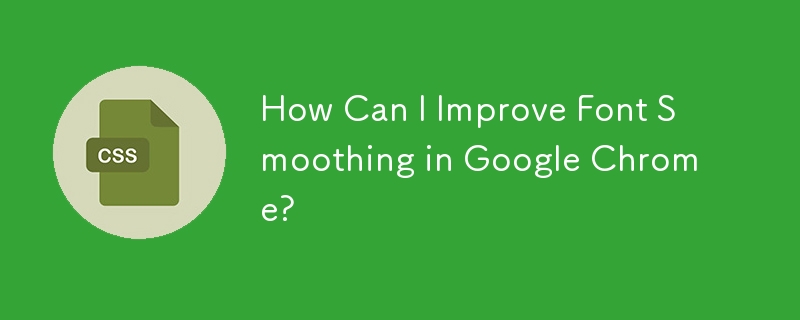
Font Smoothing in Google Chrome: A Comprehensive Guide
The quality of font rendering in Google Chrome has been a topic of discussion and frustration among web developers for some time. While Google Webfonts generally appear crisp and clear at larger font sizes, they often render poorly at smaller sizes, especially in Chrome.
Current Status (June 2014)
Google Chrome 37, released in July 2014, introduced a fix that significantly improves font rendering. Developers can now expect Google Webfonts to appear more consistently at all font sizes.
Historical Perspective (December 2013)
Prior to Chrome 37, there were two main approaches to addressing font smoothing issues:
- Web Font Loading Order: By loading font files in a specific order, it was possible to improve the rendering quality of fonts loaded via CSS or Google's webfont.js script. However, this solution was not reliable across all browsers.
- Self-Hosting Fonts: Hosting fonts locally and loading them with @font-face allows developers more control over the font rendering process. By embedding TTF/OTF fonts, you can potentially bypass Chrome's problematic handling of WOFF files.
Workarounds
While the aforementioned fixes are preferable, there were a few temporary workarounds that could alleviate the problem:
- Adding Text Stroke: Applying a -webkit-text-stroke to fonts can improve their rendering by adding a slight outline.
- Using Text Shadow: A subtle text shadow can also enhance font visibility.
- Using RGBA: Using the RGBA syntax for text shadow or stroke can provide more flexibility in fine-tuning the font rendering.
Solution
The recommended solution to font smoothing issues in Google Chrome is to load fonts in the following order:
- TTF/OTF fonts
- WOFF fonts
- SVG fonts
- EOT fonts
This order prioritizes fonts that are natively supported by Chrome, resulting in the best possible rendering quality.
Additional Resources
- [How to fix the ugly font rendering in Google Chrome](https://www.matope.net/html5-css3/font-rendering-chrome-fix/)
- [Web Font Rendering in Chrome](https://www.w3.org/Graphics/SVG/WG/wiki/Web_Font_Rendering_in_Chrome)
- [Font embedding: high-quality text in web pages](https://code.google.com/archive/p/webfonts/articles/embedding.html)
The above is the detailed content of How Can I Improve Font Smoothing in Google Chrome?. For more information, please follow other related articles on the PHP Chinese website!

Hot AI Tools

Undress AI Tool
Undress images for free

Undresser.AI Undress
AI-powered app for creating realistic nude photos

AI Clothes Remover
Online AI tool for removing clothes from photos.

Clothoff.io
AI clothes remover

Video Face Swap
Swap faces in any video effortlessly with our completely free AI face swap tool!

Hot Article

Hot Tools

Notepad++7.3.1
Easy-to-use and free code editor

SublimeText3 Chinese version
Chinese version, very easy to use

Zend Studio 13.0.1
Powerful PHP integrated development environment

Dreamweaver CS6
Visual web development tools

SublimeText3 Mac version
God-level code editing software (SublimeText3)

Hot Topics
 How can I include CSS only on some pages?
Jun 11, 2025 am 12:01 AM
How can I include CSS only on some pages?
Jun 11, 2025 am 12:01 AM
There are three ways to selectively include CSS on a specific page: 1. Inline CSS, suitable for pages that are not frequently accessed or require unique styles; 2. Load external CSS files using JavaScript conditions, suitable for situations where flexibility is required; 3. Containment on the server side, suitable for scenarios using server-side languages. This approach can optimize website performance and maintainability, but requires balance of modularity and performance.
 Flexbox vs Grid: Understanding the Key Differences in CSS Layout
Jun 10, 2025 am 12:03 AM
Flexbox vs Grid: Understanding the Key Differences in CSS Layout
Jun 10, 2025 am 12:03 AM
Flexboxisidealforone-dimensionallayouts,whileGridsuitstwo-dimensional,complexlayouts.UseFlexboxforaligningitemsinasingleaxisandGridforprecisecontroloverrowsandcolumnsinintricatedesigns.
 Creating an Auto-Closing Notification With an HTML Popover
Jun 10, 2025 am 09:45 AM
Creating an Auto-Closing Notification With an HTML Popover
Jun 10, 2025 am 09:45 AM
The HTML popover attribute transforms elements into top-layer elements that can be opened and closed with a button or JavaScript. Popovers can be dismissed a number of ways, but there is no option to auto-close them. Preethi has a technique you can u
 What is 'render-blocking CSS'?
Jun 24, 2025 am 12:42 AM
What is 'render-blocking CSS'?
Jun 24, 2025 am 12:42 AM
CSS blocks page rendering because browsers view inline and external CSS as key resources by default, especially with imported stylesheets, header large amounts of inline CSS, and unoptimized media query styles. 1. Extract critical CSS and embed it into HTML; 2. Delay loading non-critical CSS through JavaScript; 3. Use media attributes to optimize loading such as print styles; 4. Compress and merge CSS to reduce requests. It is recommended to use tools to extract key CSS, combine rel="preload" asynchronous loading, and use media delayed loading reasonably to avoid excessive splitting and complex script control.
 How to use Lotties in Figma
Jun 14, 2025 am 10:17 AM
How to use Lotties in Figma
Jun 14, 2025 am 10:17 AM
In the following tutorial, I will show you how to create Lottie animations in Figma. We'll use two colorful designs to exmplify how you can animate in Figma, and then I'll show you how to go from Figma to Lottie animations. All you need is a free Fig
 Breaking Boundaries: Building a Tangram Puzzle With (S)CSS
Jun 13, 2025 am 11:33 AM
Breaking Boundaries: Building a Tangram Puzzle With (S)CSS
Jun 13, 2025 am 11:33 AM
We put it to the test and it turns out Sass can replace JavaScript, at least when it comes to low-level logic and puzzle behavior. With nothing but maps, mixins, functions, and a whole lot of math, we managed to bring our Tangram puzzle to life, no J
 External vs. Internal CSS: What's the Best Approach?
Jun 20, 2025 am 12:45 AM
External vs. Internal CSS: What's the Best Approach?
Jun 20, 2025 am 12:45 AM
ThebestapproachforCSSdependsontheproject'sspecificneeds.Forlargerprojects,externalCSSisbetterduetomaintainabilityandreusability;forsmallerprojectsorsingle-pageapplications,internalCSSmightbemoresuitable.It'scrucialtobalanceprojectsize,performanceneed
 Does my CSS must be on lower case?
Jun 19, 2025 am 12:29 AM
Does my CSS must be on lower case?
Jun 19, 2025 am 12:29 AM
No,CSSdoesnothavetobeinlowercase.However,usinglowercaseisrecommendedfor:1)Consistencyandreadability,2)Avoidingerrorsinrelatedtechnologies,3)Potentialperformancebenefits,and4)Improvedcollaborationwithinteams.






